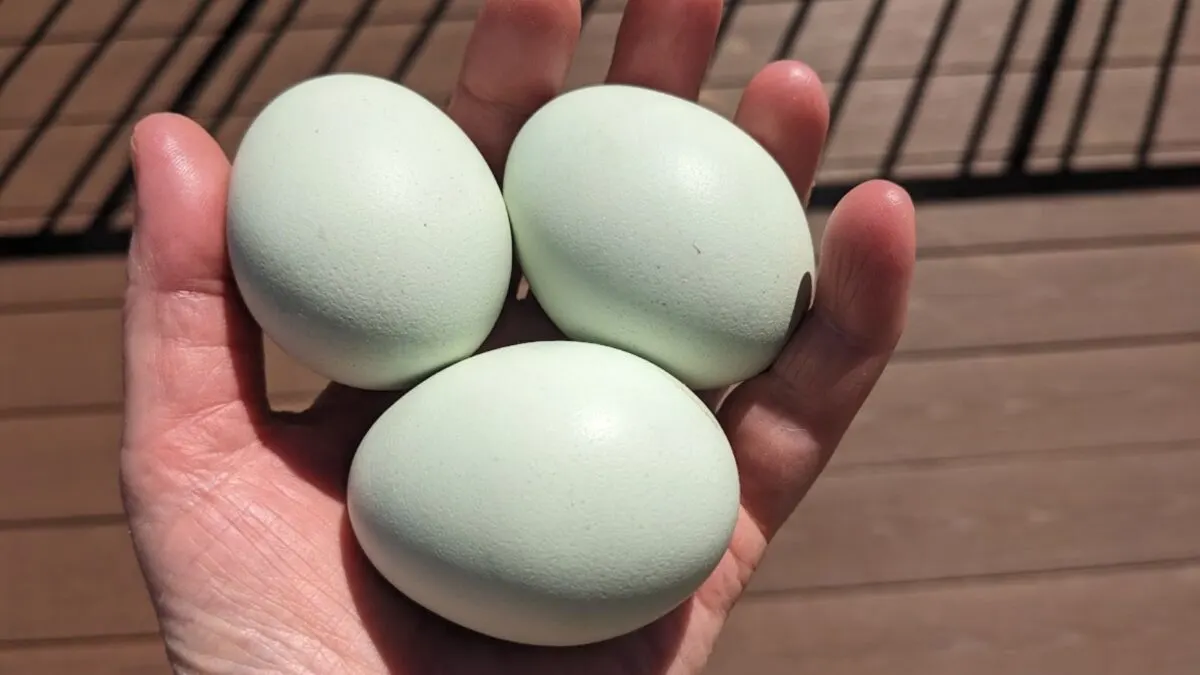Imagine the thrill of checking your nesting boxes daily and discovering a vibrant variety of chicken eggs in various colors. From classic white to shades of blue, green, olive, pink, and even rich chocolate brown, eggshell colors vary widely depending on the chicken’s breed. Here’s a quick guide to different colored chicken eggs that will give you a rainbow of egg colors in your coop.

Part of the charm of raising chickens lies in the surprise of what color eggs each hen will produce. Some breeds, like the Ameraucana, are known for their distinctive light blue eggs, while others, such as the Easter Eggers, can lay various egg colors, including green and cream.
Fun fact: Did you know that the chicken’s earlobe color often provides clues to the eggshell color?
Understanding the genetics behind these colorful eggs can be fascinating and valuable for those looking to breed chickens for specific egg colors. While some breeders aim for consistency in their flocks’ egg colors, others enjoy the diversity that comes with mixed breeds. Knowledge of chicken breeds and their associated egg colors can guide poultry enthusiasts in customizing their flocks to yield colorful eggs.
Understanding Egg Color Variations

Pigmentation basics
Eggshell pigmentation comes from two primary pigments: protoporphyrin and biliverdin. Protoporphyrin creates a brown coloration in varying concentrations in breeds like the Marans, which are renowned for their rich chocolate-colored eggs. Biliverdin creates a blue or green hue, as seen in the eggs produced by Araucanas and Ameraucanas.
Genetic factors influencing egg color
Egg color is a trait firmly rooted in a chicken’s genetic makeup. The gene Oocyan, present in some breeds, triggers the production of biliverdin, resulting in blue eggs. Breeds such as Easter Eggers possess a unique genetic trait, allowing them to lay eggs in shades of blue, pink, or cream. The genetic cross of breeds can lead to new egg colors, like the olive eggs produced by Olive Eggers, a mix of blue and dark brown egg layers.
Common Egg Colors and Their Sources

Pink eggs

Pink eggs are rare and typically light in color with a slight pinkish hue. They are often laid by breeds like the asil, barred rocks, and some Easter eggers, known for producing eggs in various pastel colors, including pink.
Learn more about chickens that lay pink eggs.
White eggs
White eggs are laid by several chicken breeds, such as the Leghorn, Polish, known for their prolific egg-laying abilities. The egg’s color stems from the absence of pigments during formation in the hen’s oviduct.
Brown eggs

Chickens like the Rhode Island Red and Plymouth Rock are famed for their brown eggs. The depth of brown coloring can vary from light to dark chocolate, attributed to the pigment protoporphyrin deposited during the egg’s development.
Learn more about chickens that lay brown eggs.
Blue eggs

The Ameraucana and Araucana breeds lay stunning blue eggs. The blue color is created by the oocyanin pigment, which permeates the entire eggshell.
See what chickens lay blue eggs.
Green eggs

The green color results from a blue eggshell with a brown pigment overlay, usually found in Easter Eggers or Olive Eggers, a mixed-breed of chickens resulting from the breeding of a bird carrying the blue-egg gene with one that lays brown eggs. Eggs from these birds may be any shade of green, gray, brown, or occasionally pink or pale yellow.
Here are five breeds of chickens that lay green eggs.
Speckled and multicolored eggs

Various breeds produce eggs with speckles or multiple colors, adding character to each egg. For example, the Welsummer lays eggs with dark brown speckles. The appearance of these patterns varies with factors such as breed and individual genetics.
We have a Black Asian chicken that occasionally will lay a speckled egg; she gave us both brown and white speckles. These adorable speckled eggs always make me happy 🙂
Frequently Asked Questions

What determines the color of a chicken’s egg?
The hen’s genetics primarily determines the color of a chicken’s egg. However, factors such as breed, age, and diet can influence the shade.
Typically, a hen’s earlobe color hints at the egg color she will lay. White earlobes often indicate white or lightly tinted eggs and red earlobes usually indicate brown eggs.
Can a chicken lay different colored eggs?
Not really. Chickens will lay the same color egg throughout their lives. However, as they age or with the change of seasons, they may have heavier or lighter blooms, which may make it seem that they are laying a different color egg, like the Black Asian chicken I mentioned above. Her usual egg had a purple hue, but occasionally, when she was short on bloom, she’d lay a speckled egg.
Does egg color affect the taste or nutritional content?
No, the color of the eggshell does not influence the taste or nutritional content of the egg. The diet and health of the hen are the primary factors that affect these qualities.

